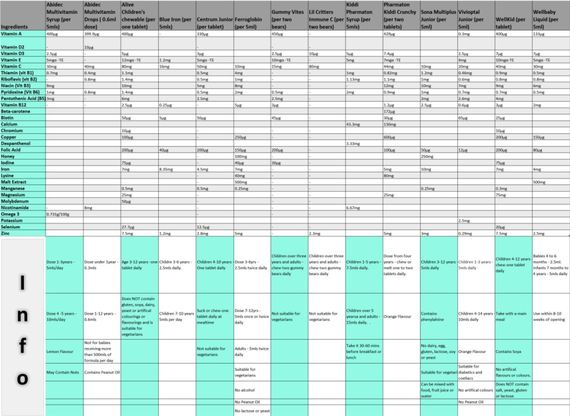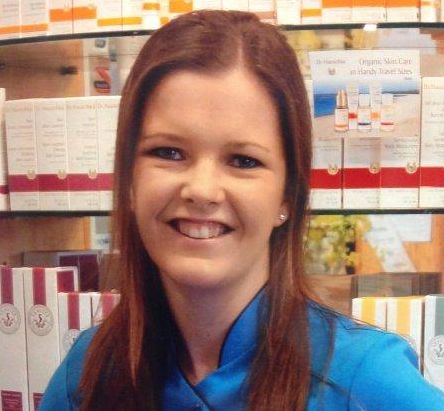
We always get advertising material into the Pharmacy from all of the different multivitamin brands, making great claims about the benefits of their own products. Even pharmacists and pharmacy staff can find it overwhelming, trying to decipher what the actual vitamin content is, and determine the benefits and downfalls of one product in comparison to another. The vitamin market is a particularly busy one! There are so many different products, and they all have strengths and weaknesses, so I have done my best to select the 14 most popular children’s multivitamins. I have literally laid them side by side, so we can explore which product meets your individual child’s needs.
I’d like to point out at the beginning that vitamin supplements are extremely useful – but there’s no beating a balanced, healthy diet! However, as an Irish mum as well as a pharmacist, I understand that there are guidelines in place which support the use of vitamin D supplementation - due to the fact the we live in one giant big grey gloomy cloud! Also, I understand and have seen first-hand that whilst I may make every effort to provide a fully nutritionally balanced diet for my kids (I said I may make every effort..most of the time…I’m not actually WonderMama…), they may still turn their noses up at it and refuse to eat it for many various reasons - depending on what developmental stage they are going through, or what illness is affecting them. Anyway, I’ll get back to the review!
There are a few things to consider before looking at the comparison… the first is that you will probably need to zoom in on the image to read the content, as there is just so much information that it makes quite a detailed chart! The next is that, to put any sort of law and order on the products, and to make any sort of logical comparison; I had to compare by volume and not always by dose…this sounds complicated, but in essence what is on the chart is the vitamin or supplement content per 5mls of liquid. So, depending on your child’s age and the product directions, your child may need to take a different number of mls (2.5mls, 5mls, 7.5mls, etc). It is important to take this into account when you are reading the chart.
Always check the dose for your child’s age group first so that you can draw a fair comparison of the products. I have included all of the dosage and special information for all products in the ‘info’ section, which is the lower section of the chart. For tablets, I have noted at the top, beside the product name, how many tablets are needed to deliver the quoted levels of vitamins.

I hope this chart will be beneficial to parents and pharmacy staff alike, in an effort to provide clarity and clear healthcare for our WonderBabas who deserve the best of our efforts to make the right choices. Information is power, and that is what WonderBaba is all about!
I have included information relating to the suitability of each product for vegetarians, coeliacs, diabetics, those with nut allergy, lactose intolerance, soy intolerance, and more. If you would like further information, please don’t hesitate to get in touch via facebook messenger at the @wonderbaba page, and I will get back to you as quickly as I can.
In this blog, I planned on summarising the benefits of each different multivitamin or supplement but, due to the vast amount, I have decided to break these up and I will produce the WonderBaba Vitamin and Supplement Series over the next few weeks. There, I will explain the benefits of each of the ingredients mentioned below, so keep an eye on the blog and the Facebook page to see these arrive day by day!
I hope you find this really helpful when trying to figure out the best choice for your WonderBaba. Here are a few general pieces of information you should be aware of before you make your choice:

- It is recommended by the HSE that all infants, from birth to 12 months - whether breastfed or formula fed - be given a daily supplement of 5 µg (200 IU) vitamin D. This is available as ‘vitamin D drops’ in all pharmacies, as a stand alone vitamin.
- If your baby is exclusively breastfed, and you are giving the recommended additional dose of vitamin D, your baby will have a nutritionally complete diet up to six months of age. At that stage, milk consumption reduces due to the introduction of solids, and so a balanced and healthy diet then becomes essential. I would like to add that whilst milk consumption often decreases, the frequency and habits of feeding commonly do not; so, continue to enjoy your breastfeeding relationship in this case, and remember the vast array of benefits you are providing to yourself and your child. According to WHO, breastfeeding continues to provide up to half or more of a child’s nutritional needs during the second half of the first year, and up to one-third during the second year of life – for the remainder, your child is dependent on the food they consume. So, whilst I am a huge advocate of breastfeeding, it is important to recognise the possible role vitamin supplementation may have if your child’s diet lacks a nutritional balance due to periods of sickness, loss of appetite or even fussiness.
- Bottle fed babies who are having more than 500mls of formula a day do also not need further supplementation, as their milk is fortified with the vitamins that they need.
- In the UK, the Department of Health recommends that all children aged six months to five years are given vitamin supplements containing vitamins A, C and D every day (other than those on more than 500mls of formula as it is possible to consume too much Vitamin A which can be harmful).
- It is important to keep any supplements tightly capped and away from children’s reach.
Here is the comparative chart for the 14 top selling children’s multivitamins in my pharmacy – Milltown Total Health Pharmacy, in Dublin 6. Remember to check the dosage info, to do a fair comparison depending on the age of your WonderBaba! You can find a clearer version of the chart HERE.

From seeing the table, you can see that each product does indeed have its own strengths and weaknesses. You may feel your child has specific requirements, and you may be able to fine-tune your choice now that you can see the products side by side. My overall view would be that, for young children aged seven months to four years, Vitabiotics Wellbaby Liquid is a strong contender as an overall multivitamin.
Remember that children who are consuming more than 500mls of formula a day should not receive a multivitamin, as it may be harmful due to excess levels of fat soluble vitamin A. These children should receive vitamin D supplementation only. Vitamin D drops are available by clicking here, and should be given to all babies from birth to one year, whether breast or bottle fed.
For children aged three years and up, one of the clear leaders is Alive Childrens Multivitamins; but this is closely followed by Pharmaton Kiddi Crunchy and Vitabiotics Wellkid, which are both suitable from four years. As those three are all chewable tablets, it’s important to mention that Vivioptal Junior Liquid would offer a reasonable alternative if your child will not take a tablet.
A most important thing for me to mention here is that this has been a completely independent review, with zero bias involved. None of the companies mentioned were even aware that I was doing a comparison so, as always, the results are transparent and I hope I have presented them clearly enough to you for them to speak for themselves.
Sheena will be at our Parenting Masterclass next month, on hand to answer all of your questions and queries. Book your spot now, through the link below.








